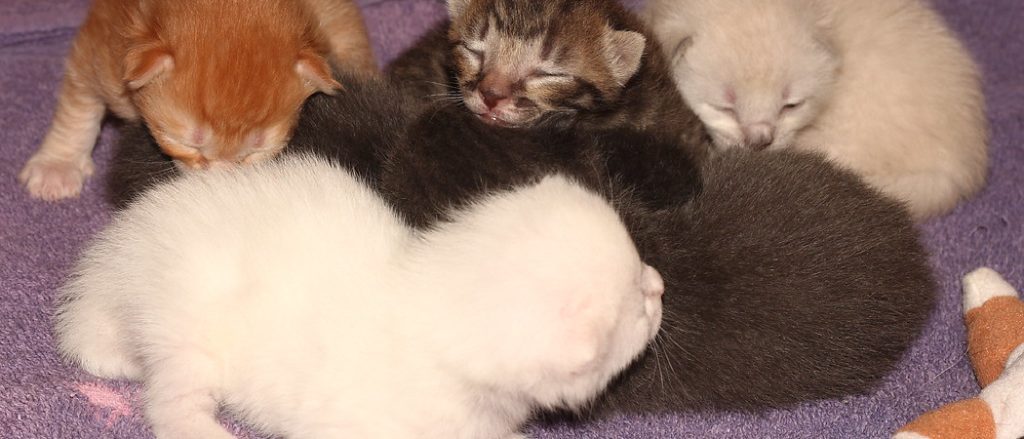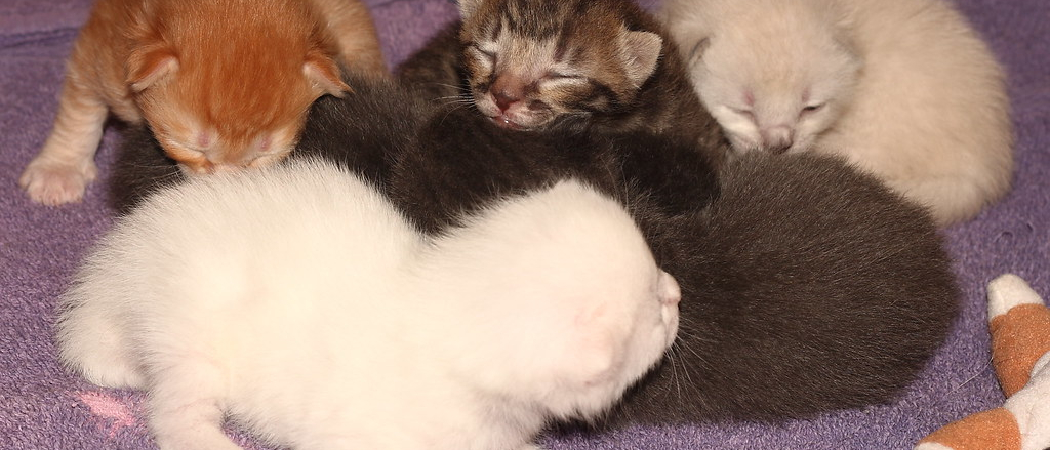After a cat gives birth, she will immediately clean her kittens and start nursing them. Typically, the mother cat will remain with her kittens, providing them with milk, warmth, and protection.

She will also continue grooming them, stimulating their digestive system, and teaching them essential skills as they grow. Additionally, the mother cat will establish a close bond with her kittens during this time, staying vigilant to any signs of danger.
As the kittens become older and more independent, the mother cat will gradually wean them off her milk and begin encouraging them to explore their surroundings. Ultimately, the mother cat’s role is to ensure the survival and development of her kittens until they are ready to venture out on their own.

Credit: www.reddit.com
The Birth Of Kittens
A cat giving birth to a litter of kittens is a remarkable experience. It’s a crucial moment that marks the beginning of a new life cycle. Understanding the process and what happens after a cat gives birth can help you provide the necessary care and support to ensure the health and well-being of both the mother cat and her newborns. In this article, we will explore the stages of labor and the role of the mother cat during this extraordinary event.
The Stages Of Labor
When a mother cat is about to give birth, she goes through several stages of labor. It is essential to recognize and understand these stages in order to provide the appropriate assistance and care. The three main phases of labor are:
- Stage 1: Preparation
This initial stage, which can last up to 36 hours, is when the mother cat starts to exhibit signs of discomfort and restlessness. She may search for a secluded area, nest, or make repetitive scratching motions. It is crucial to provide her with a quiet and calm space during this time.
- Stage 2: Active Labor
During active labor, the mother cat begins to experience contractions, and the actual birth of the kittens takes place. This phase can last anywhere from a few minutes to several hours, depending on the size of the litter. It is important not to intervene unless necessary, as the mother cat usually instinctively knows how to handle the process.
- Stage 3: Afterbirth
After each kitten is born, the mother cat will expel the placenta, which is commonly known as the afterbirth. The mother will typically clean the kittens and stimulate them to breathe by licking them. It is crucial to ensure that all the placentas are expelled and that the mother cat is adequately caring for her newborns.
The Role Of The Mother Cat
The mother cat plays a vital role in the birth and care of her kittens. Instinct kicks in during this time, and she will usually take care of most aspects of the process. Here are some important responsibilities of the mother cat:
- Nesting: Before giving birth, the mother cat will create a nest-like area where she feels safe and comfortable. This is where she will birth and nurse her kittens.
- Cleaning and Stimulating: One of the first things the mother cat does after birth is clean her kittens. This helps to remove any amniotic fluid and stimulates their breathing. The mother’s tongue is rough, which helps to remove the mucus from the kittens’ airways and stimulate blood circulation.
- Feeding and Nurturing: The mother cat will nurse her kittens and provide them with the necessary nutrition for their growth and development. She will also groom and cuddle with them to provide comfort and warmth.
- Maintaining the Nest: The mother cat will keep the nest clean by consuming the kittens’ waste and grooming their bottoms to stimulate their elimination and urinary reflexes. This helps to establish good hygiene practices in the early stages of life.
Understanding the stages of labor and the role of the mother cat after a birth is crucial for ensuring the well-being of the newborn kittens. By providing a calm and supportive environment, as well as monitoring the mother cat’s behavior and the kittens’ development, you can help create the best possible start for these adorable little creatures.
Credit: www.quora.com
Caring For Newborn Kittens
After a cat gives birth, caring for newborn kittens is crucial. It involves providing warmth, stimulating bowel movements, and ensuring they receive proper nutrition through nursing or bottle feeding, as well as monitoring their health and socialization.
The Importance Of Colostrum
Colostrum plays a vital role in the health and development of newborn kittens. This rich, yellowish fluid is produced by the mother cat for the first few days after giving birth. It is extremely important for the kittens’ immune system as it contains high levels of antibodies that help protect them against infections and diseases. Feeding the kittens colostrum within the first 24 hours of birth is crucial, as their bodies are developing and need this extra boost of immunity.
Feeding And Hydration
Proper feeding and hydration are key aspects of caring for newborn kittens. Initially, the mother cat will nurse her kittens, providing them with the necessary nutrients for growth and ensuring they stay hydrated. If the mother cat is unable to nurse or there are orphaned kittens, bottle-feeding becomes essential.
When bottle-feeding, it is important to use a specialized kitten milk replacement formula, as cow’s milk can cause digestive issues. Feeding should be done with a small, sterilized bottle or syringe every two to three hours. Ensuring the kittens are properly burped after each feeding is crucial as it helps prevent gastrointestinal discomfort.
In addition to feeding, hydration is also essential for the kittens’ well-being. A shallow dish of water should be introduced when the kittens are around three to four weeks old. It is important to monitor their water intake and ensure the dish is kept clean and easily accessible.
Maintaining A Warm Environment
Newborn kittens are unable to regulate their body temperature effectively, so maintaining a warm environment is crucial for their survival and comfort. The ideal temperature for newborn kittens is around 85 to 90 degrees Fahrenheit (29 to 32 degrees Celsius).
Provide a warm, enclosed nesting area for the mother cat and her kittens, ensuring it is quiet and free from drafts. You can use a cardboard box lined with soft blankets or purchase a dedicated kitten bed. Using a heating pad or a hot water bottle wrapped in a towel can help maintain a consistent temperature.
Regularly check the kittens’ body temperature to ensure they are neither too hot nor too cold. Signs of hypothermia include cool extremities, lethargy, and crying. If the kittens feel too cold, you can gently warm them by placing them against your skin or using a heating pad on a low setting. However, avoid overheating them, as it can be equally dangerous.
Kitten Development And Socialization
Understanding the development and socialization of kittens is crucial for cat owners. Once a cat gives birth, it’s important to provide a nurturing environment that supports the growth and social skills of the newborn kittens. In this section, we will explore the identification and sexing of kittens, their developmental milestones, and the significance of socialization and play in their early stages of life.
Identification And Sexing
Identifying newborn kittens may seem challenging, but it can be done with careful observation. One way to differentiate between kittens is by examining their coat colors and patterns. Kittens can have various coat patterns, such as tabby, solid, calico, or tortoiseshell. This distinctiveness aids in identifying individual kittens within a litter.
In addition to coat patterns, another important aspect of identification is sexing the kittens. Sexing kittens involves determining their biological sex. This can be achieved by gently lifting the tail of the kitten and observing their genital area. Female kittens usually have a small vertical slit, while male kittens possess a rounder and more prominent opening.
Developmental Milestones
As time goes by, newborn kittens rapidly enter various developmental milestones. It is important to be aware of these milestones and provide the necessary care and support during each stage of growth. Here are some significant developmental milestones to expect:
| Milestone | Description |
|---|---|
| Eyes Open | At around 10 to 14 days, the kittens’ eyes begin to open, allowing them to explore the world visually. |
| Weaning | Between three to four weeks, the kittens start transitioning from their mother’s milk to solid food as their teeth start developing. |
| Coordination | At around four to five weeks, kittens become more coordinated and start exploring their environment, including climbing and playing. |
| Litter Training | Between four to six weeks, kittens can be introduced to litter training, gradually learning to use a litter box. |
Socialization And Play
Perhaps one of the most critical aspects of kitten development is socialization and play. Kittens learn valuable social skills through interaction with their mother, littermates, and humans. Playing is essential for their physical and mental development.
Providing an environment enriched with engaging toys and interactive playtime fosters healthy growth and contributes to their overall well-being. It’s also important to introduce kittens to various sounds, sights, and experiences during their early weeks to ensure well-rounded socialization.
By engaging in play and offering regular affection and positive reinforcement, cat owners can establish strong bonds with their kittens. This early socialization and playtime set the foundation for their future relationships and behavior.

Credit: www.amazon.com
Frequently Asked Questions Of What Happens After A Cat Gives Birth
What Are The Signs That A Cat Is About To Give Birth?
Cats may display nesting behavior, restlessness, and an increase in body temperature as signs that they are about to give birth.
How Long Does It Take For A Cat To Give Birth?
A cat’s labor generally lasts between 2 to 24 hours, with each kitten being born around 15-30 minutes apart.
How Many Kittens Can A Cat Have In One Litter?
Cats can have anywhere from 1 to 12 kittens in one litter, depending on factors such as the cat’s age and breed.
What Should I Do After My Cat Gives Birth?
After your cat gives birth, provide a warm and quiet environment for her and her kittens. Make sure she has access to fresh water and nutritious food.
Conclusion
After the arrival of adorable kittens, it’s essential to provide proper care and attention to both the mother cat and her newborns. From ensuring a clean and comfortable environment to regular veterinary check-ups, these crucial steps ensure the health and well-being of the little feline family.
Remember to be patient and supportive, as the mother cat requires time to recover and bond with her kittens. By following these guidelines, you can ensure a smooth and joyous experience for both the cat and her new litter. Celebrate the miracle of life and enjoy watching the kittens grow!


